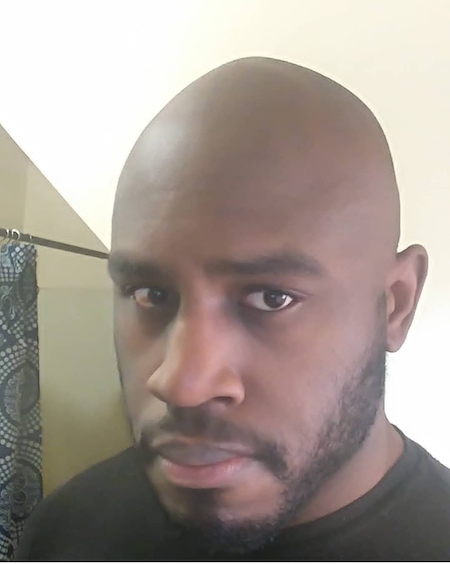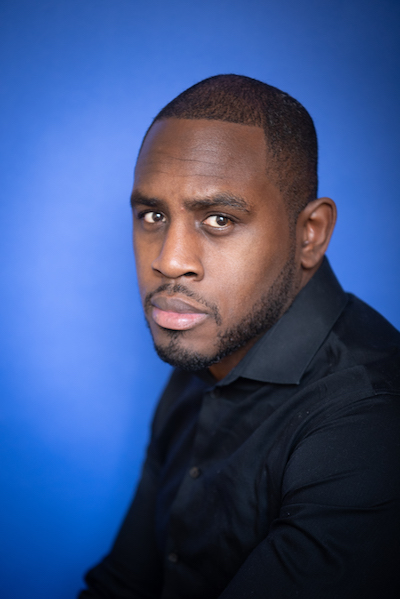I don’t remember when I started losing my hair. I don’t think most who suffer from male pattern baldness ever do. However, most of us remember when someone else points out that we’re losing hair.
When I was 27, a guy I boxed with pointed out that I was going bald. At age 28, one of my drill sergeants at basic training (I enlisted relatively late) made a joke about it.
I tried minoxidil (Rogaine foam) with hardly any results. I also tried finasteride (Propecia) pills, but I stopped because I got a strange pain in my groin that lined up with a lot of the crazy symptoms I’d read about in regards to Propecia.
Eventually, I got 2 FUE hair transplants and I got back a full head of hair. Except there was only one problem: It’s possible to still lose hair that hadn’t fallen out.
Read about my experience getting an FUE hair transplant

This meant that I would need to do something to keep my remaining hair from falling out. From that problem, my hair retention protocol was born.

Warnings about the hair retention protocol
Before I tell you what to do, I have to give you a few caveats about this protocol.
You have to be patient
It’s possible that when I first tried Minoxidil, I didn’t give it enough time to work. With that said, it’s widely known that Minoxidil works best at slowing down hair loss and hair shedding. Most people don’t experience regrowth. I could have been one of the guys that experience hair regrowth, but I just didn’t stick with it long enough to find out.
The hair retentional protocol has a fairly high success rate but is not instantaneous. It will take 6-12 months for any noticeable changes to happen. You’ll stop losing hair almost immediately, so things shouldn’t get much worse (except for the temporary shedding), but it takes a small amount of time for things to get better.
You have to be early
This protocol works best if you start implementing it before you need to. Ideally, you’d start using it right before your scalp starts to react to DHT and you notice extra hairs in the drain, a thinning crown, and a receding hairline. Realistically, you’ll be a little late to the party. Because of the way hair loss happens, it’’s a lot easier to maintain the hair that you have that it is to regrow hair once it’s fallen out.
I recommend you start this routine no later than 25. If you have a history of male pattern baldness in your family, I recommend starting it ever sooner, maybe even in high school.
You have to be realistic
This is a routine to keep existing hair. While there is evidence that some people have regrowth—and it can be quite significant in some cases—it’s better to assume that you’ll be a case of someone who merely stops hair loss and experiences a low/moderate amount of regrowth.
If you’re at Norwood stage 5, then you can’t expect this protocol to get you back to a full head of hair. It can, however, stop things from getting worse and it might give you significant regrowth.
You’ll have to spend some money
But not nearly as much money as you’ll have to spend on a hair transplant.
Granted, I am pleased with the results of my FUE hair transplant (you can read all about it here—>My experience getting an FUE transplant), but that is nearly $20k I could have used for something else. That’s ok, though, because of the next point.
You have to be a vain
I don’t think vanity is a bad thing. Like many traits, it’s only a problem if let it get out of control. You have to care enough about your appearance to spend the money and stay consistent. Some guys can’t imagine why I’d spend the money and time maintaining a full head of hair.
These guys usually just let nature take its course, eventually resorting to just shaving it all off. However, I know the power of appearances and I know that I simply look better with a full crown and sharp hairline.
With all of those things out of the way, here is the routine I use to maintain the hair I have left now that I’ve replaced enough to care about keeping what’s left.
How this protocol stops early hair loss (and can even reverse some intermediate hair loss)
The strategic aims of the hair loss prevention/retention plan are as follows:
- Regulate the body’s natural production of DHT (i.e., no ingestion of finasteride/propecia)
- Neutralize and overpower the effect of DHT in the scalp
- Address insulin resistance
- Address inflammation
This will be accomplished for a fraction of the cost of a full-blown FUE transplant.
Even the most expensive version of this protocol will cost less than $100/month and it will *definitely* (95-99%) stop your hair loss. It will *almost certainly” (70-95%) thicken the hair you have remaining (why this program is ideal for catching hair loss early, and it has a *pretty good chance* (50-60%) of regrowing your hair.
How DHT works and why it causes hair loss
Dihydrotestosterone (DHT) is a derivative of testosterone. About 10% of the testosterone in the body is converted to DHT with the help of the enzyme 5-alpha-reductase (5AR). DHT can link to your hair follicles and cause them to shrink. While this is obviously an undesirable outcome, DHT is a vital hormone for masculinity.
DHT contributes to male secondary sex characteristics such as:
- a deep voice
- body hair and muscle growth
- growth of the penis, scrotum, and testicles
- Male fat storage patterns
If we lower DHT in the whole body, we essentially erase a vital chemical component of what makes a man a man. Proof of this is what happens when you lower DHT levels. You display traits such as
- Loss of body hair
- Gynecomastia
- Decreased libido
- Increased weight gain
- Erectile dysfunction
These adverse effects are why I’m against taking oral Propecia (1 mg finasteride) or Proscar (5 mg finasteride) to slow down hair loss. I like a nice full of head of hair as much as the next guy, but I’m not willing to suffer through those side effects to get my hair back. Put another way, the costs of finasteride exceeds its value.
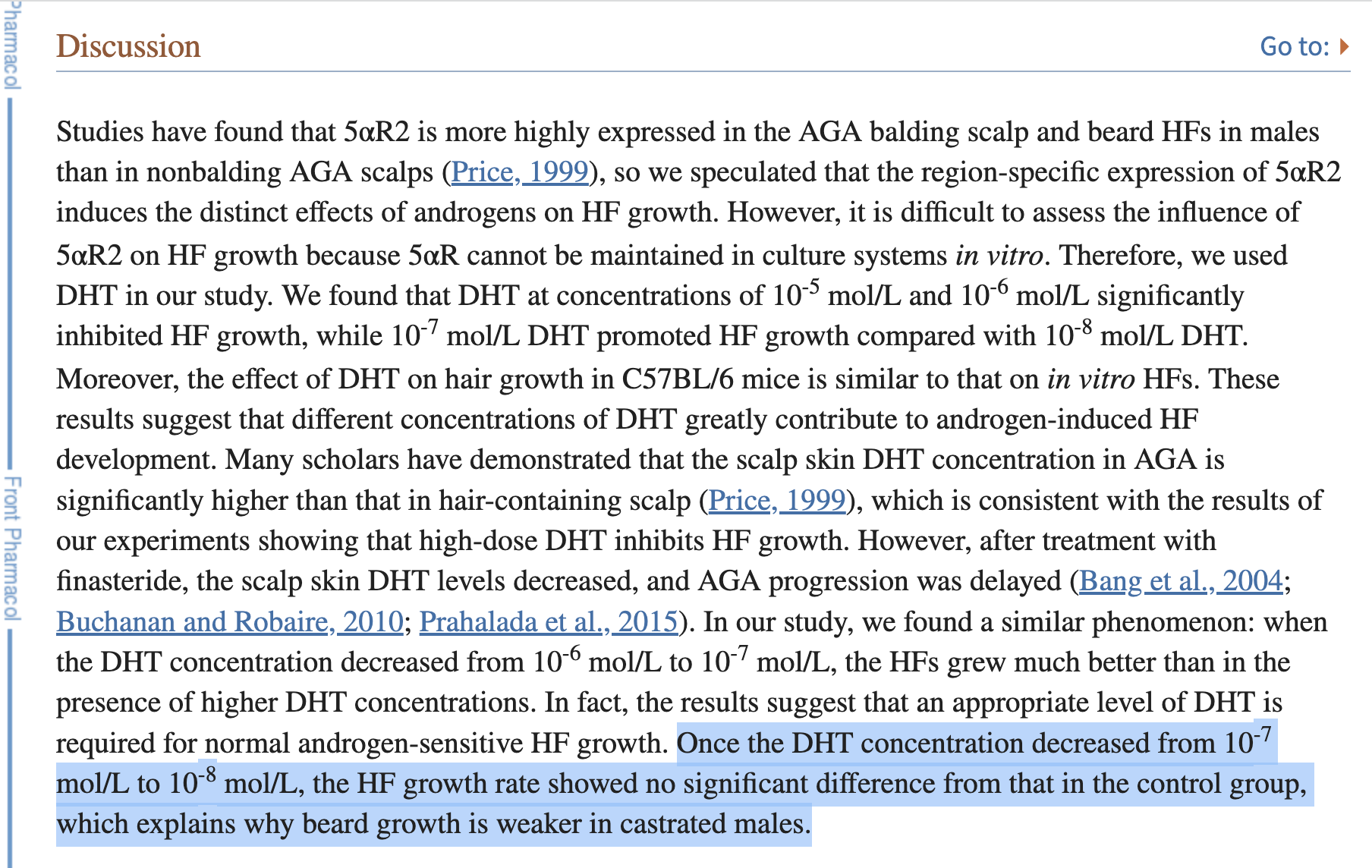
DHT binds with androgen receptors, and it’s been found that there are both more androgen receptors and DHT in the scalp where balding occurs than in the areas resistant to balding. This is why the hair in these areas almost never falls out and are used as the donor site for hair transplants.
Experts believe that hair loss occurs due to increased concentrations of both 5-alpha-reductase and androgen receptions, they are not sure exactly how it works. The probable theory put forth is that the same gene which controls the hair follicles growth cycle is influenced by the androgen DHT(Source).
While the following is causative, it’s strong correlation and confirms why certain treatments work and others are just snake oil:
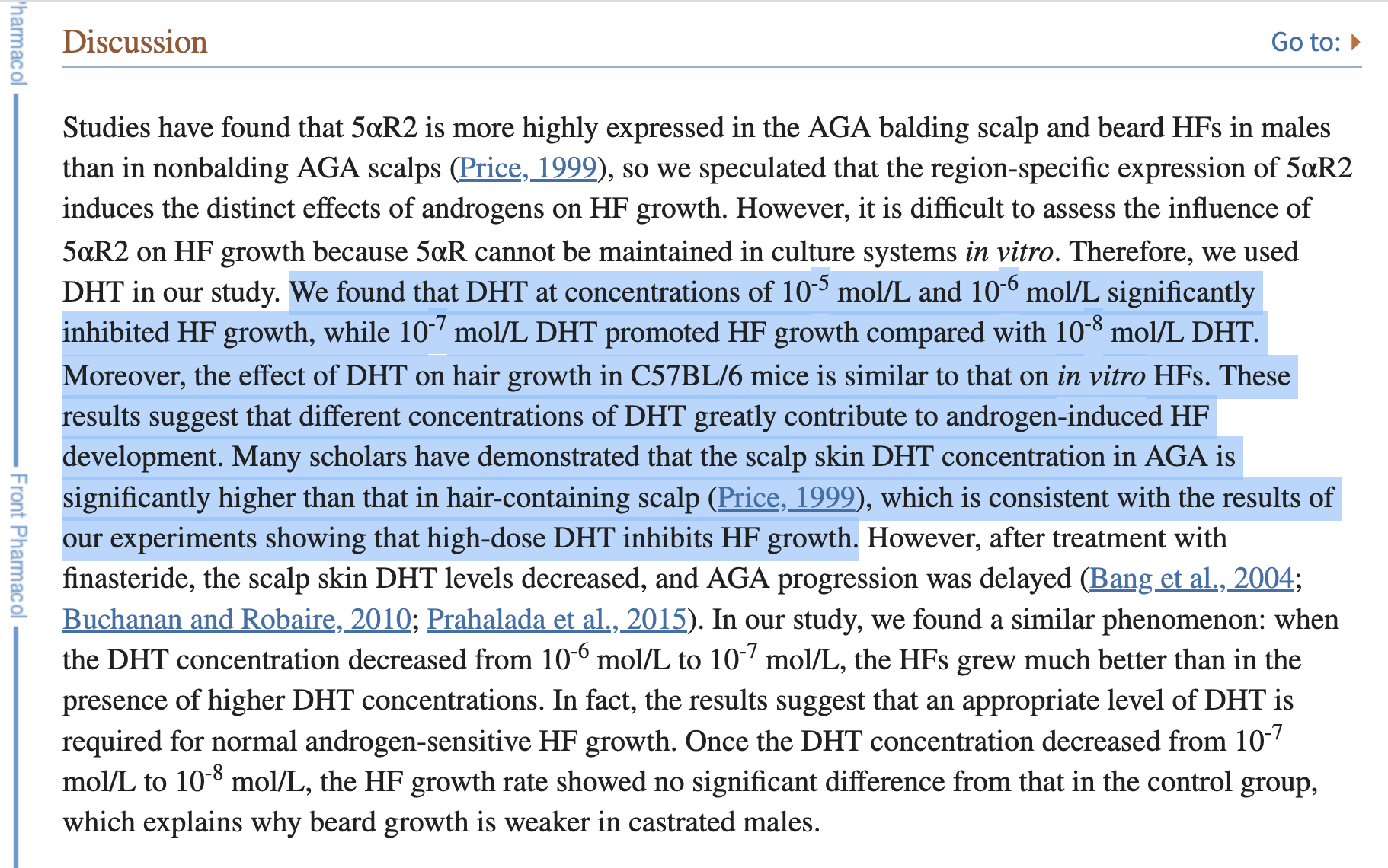
It’s also worth noting that there are negatives when DHT levels in the body are too high. High levels of DHT cause acne, a receding hair line, and hair loss at the crown. The last two issues make sense and is what this article is devoted to stopping, but the acne is issue is one that many people outside of the bodybuilding world aren’t familiar with.
Many guys who are on steroids that increase testosterone (and thus increase DHT conversion) get acne for exactly this reason. Their testosterone levels are elevated so now their bodies have more testosterone to convert to DHT. Those this can happen naturally as well from increases in muscle and lowering body fat (activities which increase testosterone), back acne is typically the result of artificially inflated levels of testosterone being converted to DHT.
The role of inflammation and fungus in male pattern baldness
DHT gets all the attention for male pattern baldness (and rightfully so), so many people are completely unaware of inflammation’s role in hair loss. We know from research like this that inflammation plays a significant role in hair loss.
In that research, the majority of scalp samples had elevated levels of lymphocytes, histiocytes, mast cells, and CD4 t cells. The presence of these all signify that a significant part of losing hair is the collateral damage between your immune system and fungus and microbes in the environment.
If you’ve never heard this before, it might sound far fetched, but the main cause of dandruff is not actually dry skin. It’s a fungus known as malassezia and it exists on the scalp of most adults. Now, if most people have this fungus on their scalp but not everyone suffers from a receding crown or temples, then what’s going on here?
Well, it’s not exactly that fungus but it’s some fungus. And we know that by treating the scalp with antimicrobials and antifungals, we promote hair regrowth and a decrease of the markers of inflammation. From this study on treatment with antimicrobial and antifungal lotion:
Androgenetic alopecia (AGA) is a common yet poorly understood condition. In particular, the significance of inflammatory cells close to the infrainfundibulum of transitional hairs remains obscure. This study was conducted in 20 men who used a lotion containing the antimicrobials, piroctone olamine and triclosan, regularly for 18 months. At entry, mild pruritus and abnormal hair loss were reported by the volunteers. During treatment, pruritus resolved rapidly. Comparison of clinical photographs and trichograms taken at 3-month intervals suggested signs of hair regrowth with moderate increase in density of transitional hairs.
The role of insulin resistance in androgentic alopecia
Insulin resistance is when your muscles, fat, and liver doesn’t respond well to insulin and can’t easily take up glucose from your blood. As a result, your pancreas makes more insulin to help glucose enter your cells.
Insulin resistance is always accompanied by another condition called “hyperinsulinemia,” which means “elevated insulin.” This makes sense, as the pancreas must continue to keep your insulin levels elevated to deal with the glucose in your bloodstream.
Many men are insulin resistant. Numbers range from 15-40% of the worldwide population has some level of insulin resistance (source). In the United States, where most of the readers of this article will reside, 40% of young adults are insulin resistant (source).
Many men also suffer from alopecia. This doesn’t necessarily mean that one causes the other. To determine that, we need a plausible mechanism of action. Something that could link the two beyond mere correlation. Fortunately, we have that.
We know that male pattern baldness is a side effect of useful androgen DHT in the bloodstream that interacts with the hair follicles, causing them to miniaturize. Hyperinsulinemia also causes an increase in serum androgen levels, including levels of DHT (source). This relationship alone is enough to justify the role of insulin resistance in male pattern hair loss, but there is one more significant problem caused by insulin resistance.
Lastly, it is known that studies have shown a “significant reduction in sex hormone binding globulin (SHBG) levels in bald men” (source). As the name suggests, SHBG is the protein that sex hormones bind to as they transport around the body. As a reminder, the “androgens” are testosterone and DHT. They, along with estrogen, are “sex hormones.”
This study found that “there was a significant reduction in SHBG levels in bald men, compared with controls.” This study here also found the same thing. One idea here is that Low levels of SHBG have been strongly correalted to an increase in Homestatic Model Assessment of Insulin Resistance (HOMA-IR) score (source).
Lower SHBG results in higher amounts of unbound free testosterone in the blood. From there, the increased free testosterone can be converted into excessive amounts of DHT through 5-alpha reductase. This is the proposed mechanism of low SHGB leading to higher levels of hair loss.
How to slow down or reverse hair loss: The hair retention protocol
Reduce concentrations of DHT and inflammation in the scalp
We don’t want to reduce the amount of DHT circulating by using drugs. The side effects are well documented. If you have to take the medication for issues related to your prostate, ignore everything I’m saying here. This should go without saying, but let me cover my ass (again): this is not medical advice. I’m not a doctor. I’m just a dude who likes keeping his hair and has discovered some things that work.
We also need to combat inflammation. This means dealing with the causes of the inflammation response. Keep in mind that inflammation is a natural response the body has to injury or pathogen to protect you. Therefore, we’ll be dealing with the pathogens that are causing the inflammatory response.
So, our first goal is to reduce DHT concentration in the scalp and to do so WITHOUT disrupting our hormone profile. This means topical treatments. Your topical regime will take place with 3 weapons: shampoo, ointment/gel, and topical finasteride/minoxidil:
Shampoo to deal with DHT and inflammation
Tons of shampoos offer DHT blockers. I’ll tell you the two products that I use and also give you the basic ingredient list you should look for to make sure that you’re getting the real deal. I use Professional Strength Hair Restore Shampoo and Nizoral.
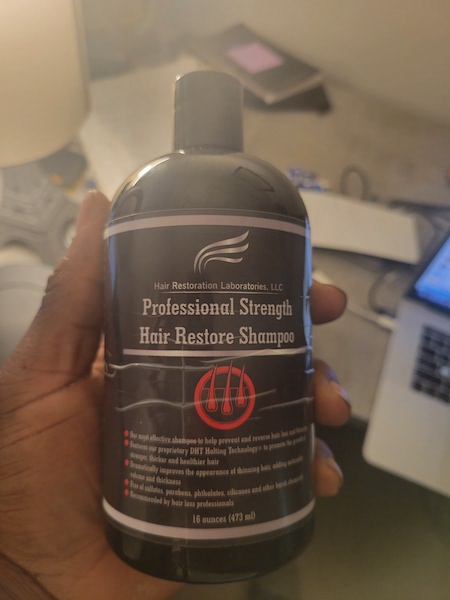
Professional Strength Hair Restore Shampoo contains a host of natural ingredients that have been shown to lower DHT concentrations in the scalp and combat inflammation. There are others, but these are the six most effective ingredients:
- Green Tea Extract: Contains Epigallocatechin Gallate (EGCG). This is the main component of green tea that stimulates human hair growth via its proliferative and antiapoptotic (preventing death) function on dermal papilla (hair follicle) cells also affects type I, 5-alpha-reductase activity that converts testosterone to DHT (Source)
- Black Seed Oil: Black seed oil is a powerful, natural antifungal, antimicrobial, antiviral, and antiinflammatory agent (Source). It is particularly effective against Candida albicans, a yeast that causes a scalp infection that can induce hair loss (Source).
- Saw Palmetto: Five randomized clinical trials (RCTs) and 2 prospective cohort studies demonstrated positive effects of topical and oral supplements containing SP (100-320 mg) among patients with androgenetic alopecia (Source).
- Pumpkin Seed Oil: Pumpkin seed oil inhibuits 5-alpha-reductase activity (Source).
- Rosemary: Rosemary has been shown to work just as well as Minoxidil with fewer adverse effects. “Both groups experienced a significant increase in hair count at the 6-month endpoint compared with the baseline and 3-month endpoint” (Source).
- Ketocanozole: Ketoconazole effectively treats the Pityriasis (also called Malassezia) fungus that commonly inhabits the scalp. It is believed that it may prevent hair loss by reducing inflammation from the fungus, in addition to have some DHT blocking properties (Source)
That last ingredient is present in small amounts, so I just went ahead and got the Ketocanozole shampoo. I like to alternate between the two. Plus the Nizoral shampoo wonderful anti-dandruff properties.
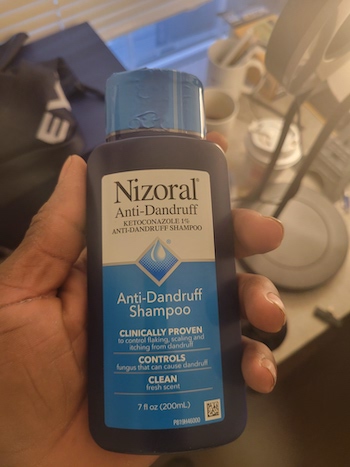
These are the not only ingredients in the Professional Strength Hair Restore Shampoo, but they are the ingredients that have produced the most significant outcomes in clinical trials.
Oilment to deal with DHT on scalp
My gel of choice is a fantastic product called “HairMetto.” It’s a simple blend of CO2 extracted Saw Palmetto Oil and cold-pressed Pumpkin Seed Oil.
I’ve cited the research on the efficacy of those two herbal treatments in reducing 5-alpha-reductase activity which leads to a higher concentration of DHT present. I’ve been using this oil as a supplement to the other parts of my hair loss regime for over a year now.
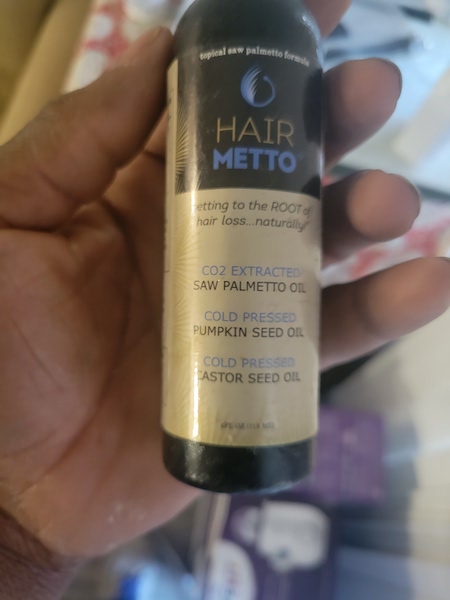
The only downside is that it’s easy to put on too much in a short amount of time, so your scalp becomes overly greasy. I apply it at night after I shower and shampoo, so this created a messy pillow case, but it’s an easy fix.
If you want to try out Hairmetto’s Topical Saw Palmetto, go here—>Hairmetto Topical Saw Palmetto
Topical minoxidil+finasteride combination
This combination is a game changer.
This is one of those technologies I wish was around when I got my hair transplant back in 2018 (Source). By itself, topical finasteride gives you all of the benefits of oral finasteride with none of the side effects. From a May 2022 review of the research on topical finasteride:
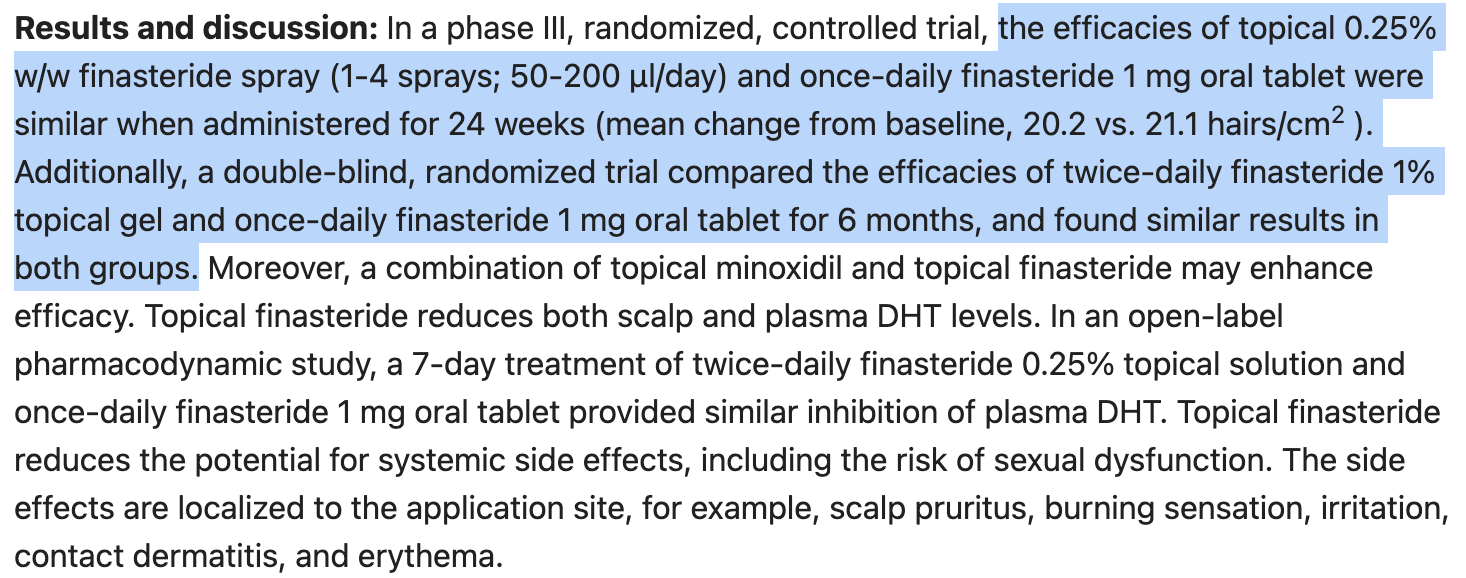
That study just mentions the effects of topical finasteride and only hints at the power of minoxidil and finasteride combined (“a combination of topical minoxidil and topical finasteride may enhance efficacy”).
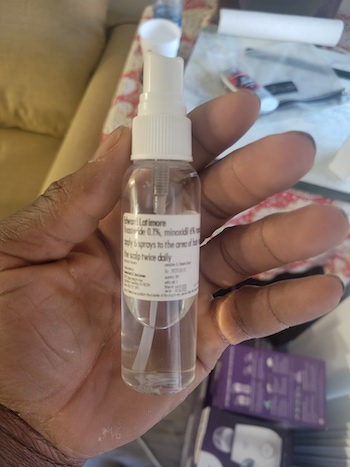
The following study demonstrates that it works just as well (and many cases, better) than taking oral finasteride and topical minoxidil separately (Study source). That study collected photographs, so it’s quite cool to see how it works.
Because finasteride is an over-the-counter medication, you’ll still need a prescription written (If you’re in the United States). I use forhims.com. They have physicians who will interview you, diagnose you, and write the script. Then a 3 months supply will show up at your doorstep every day. Check out their topical finasteride+minoxidil spray here.
Simple diet to control insulin to deal with SHBG
Our dietary changes and modifications with supplements are done to accomplish 2 primary objectives:
- Keep insulin levels as low as possible for as long as possible. Ideally, this means that we’re able to keep our insulin levels below 5 uIU/ml when fasting, and they should fall below 30 ulU/ml after 2 hours of eating.
- Keep blood sugar from spiking too high or too fast.
The reason behind this is because of what we know about the relationships between hair loss, SHBG, and insulin. A 1994 study aptly titled “The relationship between serum levels of insulin and sex hormone-binding globulin in men” found that SHBG doesn’t affect insulin, but insulin has a desynthesizing affect on SHBG (Source).
So we aim to optimize our SHBG by optimizing our insulin. The best part about this part of the plan is that it’s going to naturally get you into better shape as a result.
Let’s start with the general rules that you need to follow, 80% of the time. These don’t need to be unbreakable dogma. Rather, it’s best to look at these guidelines to follow most of the time for most meals. Of course, you can commit to eating like this for the rest of your days,every day. That’d be fine too. The guidelines are:
- If it has an ingredient label, don’t eat it. The goal here is to avoid added refined sugars and processed seed oils.
- If it’s white, don’t eat it. That’s going to eliminate sugar, flour, and bread. It also technically eliminates cauliflower and potatoes. This isn’t intentionally a low-carb diet. It removes refined and processed carbohydrates, as those are the main culprits for keeping our insulin levels elevated constantly.
- Don’t drink your calories. Water, diet soda, coffee, or tea. Not only is this another insulin management technique, but it turns out that caffeine has an inhibitory affect on DHT (Source).
- Intermittent fasting. Your insulin spikes when you eat. So snacking all day keeps insulin levels elevated all day. When you reduce your window of feeding, you reduce insulin spikes.
This lifestyle has numerous other benefits, but the one we’re primary concerned with is how it will keep the SHBG levels optimal by keeping insuli levels to a minimum, only raising them when necessary (after a delicious, healthy meal).
Supplementary tools to help slow down or reverse early hair loss
These are tools that will greatly assist you in your journey to keep your hair from falling out too early. They don’t work by reducing inflammation, DHT, or insulin levels. Their mechanism of action is a little more complex and/or not completely understood, but the research shows they work just as well—if not better—than some of these stand alone options.
Dermarolling/Microneedling
This is the only treatment that will cause you a pain. Granted, it’s not a high level of pain, but it’s the only treatment that comes with it.
It’s a simple procedure. You buy a dermaroller with 1.5 mm needles and 1-3 times a week, roll the over your scalp in a horizontal, vertical, and diagonal directions until your skin feels slightly irritated even when you aren’t rolling.
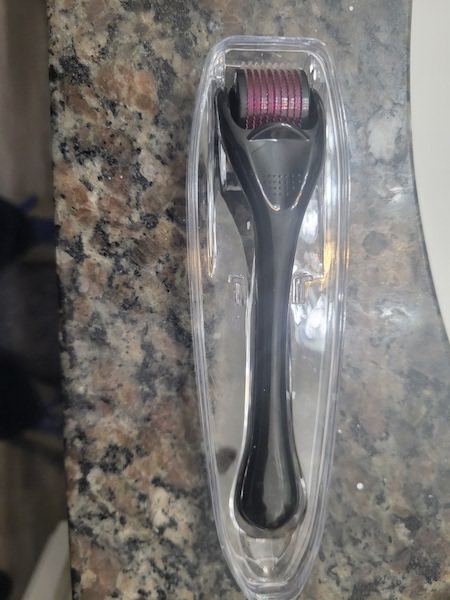
Scientist have posited a numnber of ways this could work, but no one is quite sure what the mechanism is. It’s just been shown to work.
The research that evaluated the efficacy of this technique conducted the trials with a 5% minoxidil solution to get even more powerful results (Source). Fortunately, using a topical minoxidil solution is part of the hair loss prevention protocol.
Check out my article that goes more in-depth into dermarolling and how it works here—>Dermarolling for hair loss
A free dermaroller to help you regrow hair
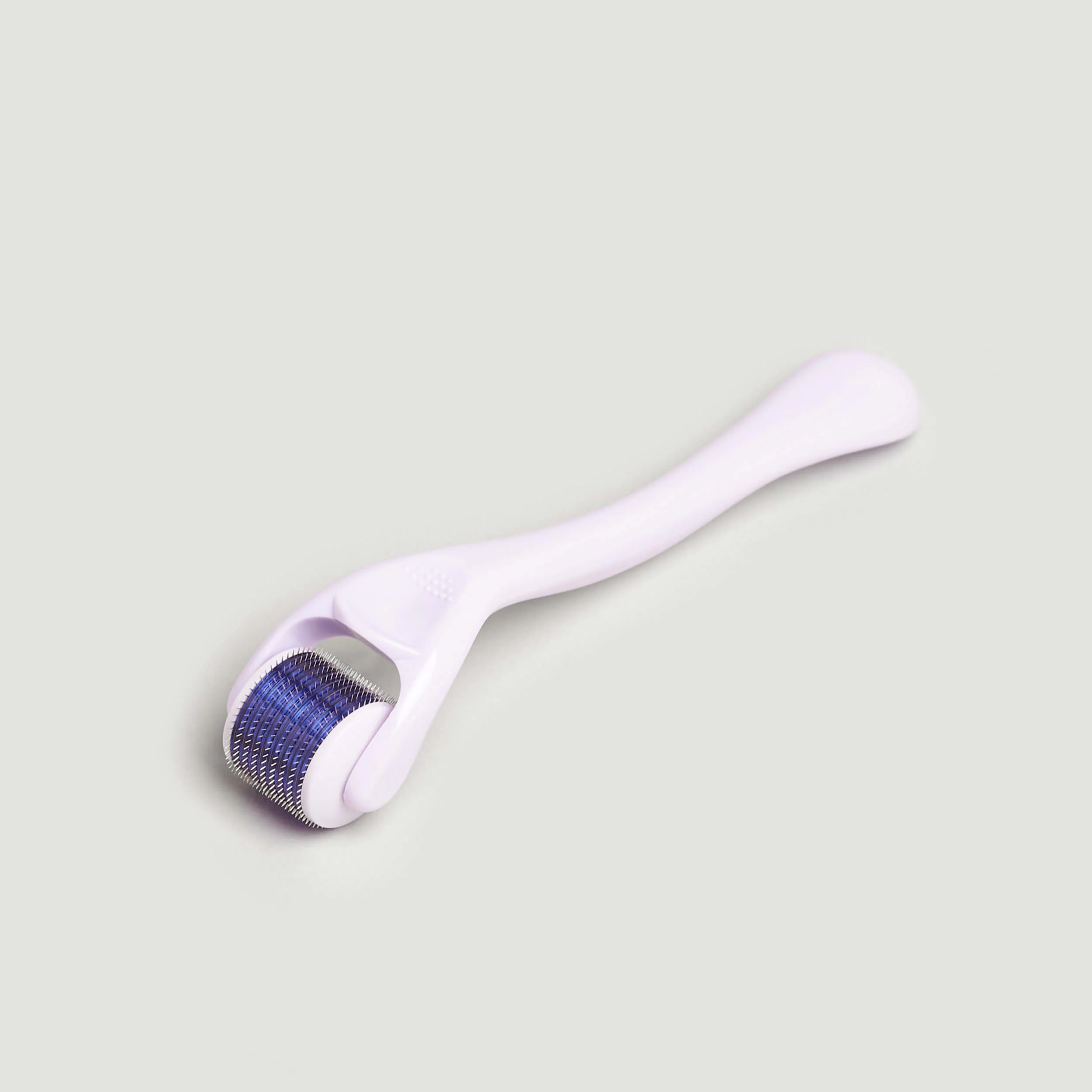
Here’s a limited-time offer from Hairguard. They will ship you a free derma roller. All you have to pay for is shipping.
The science and success stories are all over the internet. Now you can try the dermaroller that’s been designed with the exact specifications as the one used in the studies that have been shown to regrow your hair.
And for free.
Get your free dermarollerLow level laser therapy (LLLT)
Low level laser therapy is a powerful technology that use low power lasers to stimulate growth. The technology works because low level lasers have been shown to activate mitochondria.
It’s also assumed that low level light therapy shortens the telogen phase so that hair follicles enter the anagen phase more quickly. It’s also assumed to prolong duration of anagen phase by increasing rates of proliferation in active anagen hair follicles and to prevent premature passage into the catagen phase.
I wear my Bosely Low Low Level Light Therapy cap for 8 minutes a day, but there is also a second setting that is just as effective at 30 minutes every two days.
This is the most expensive option on this list (by a fairly significant margin), but it’s also the one with the highest success profile. If you’re willing to cough up the $1500, this is a fantastic entry into your repertoire.
I wrote even more about the technology of the LLLT cap here—>How LLLT works to regrow hair
Implementing the hair loss protocol
- The diet is daily. Change your eating habits immediately and live by it.
- Microneedling with a 1.5 mm dermaroller is only done 1-3 times a week. You really shouldn’t be able to do it more than than IF you’re doing it correctly.
- Wait at least 12 hours after dermarolling before you add the minoxidil+finasteride. However, you can use the HairMetto right after. I do, as it won’t sting my head. The solution contains alcohol.
- If you get the low level laser therapy cap, you can use that every day. Or every other day, if you follow that setting.
- Outside of microneedling days, I typically spray my minoxidil+finasteride combination on in the morning and in the evening. I use the Hairmetto on the days that use the dermaroller.
- I recommend shampoo every time I shower. I recommended using the Professional Strength Hair Restore Shampoo shampoo most of the time. I apply before I wash the rest of the body so that it soaks on my scalp. Then I rinse and apply one more time before getting out. On the second go through, I sometimes switch up to the Nizoral.
If you follow this hair loss protocol, you’ve got a great shot at slowing down your hair loss IF it’s caused by androgenetic alopecia. There’s a good chance this is you, so this protocol will do great and buy you some time until you can save up for a more permanent solution—like an FUE.
Until then, the rest is up to you.



